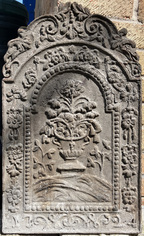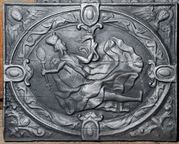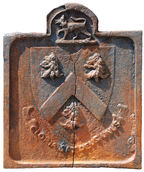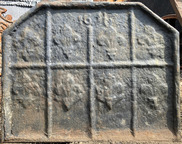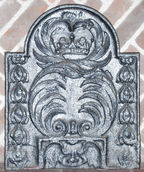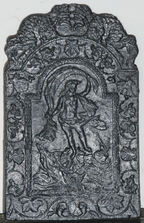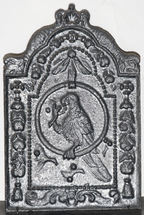-
549
Description: Arched rectangular shaped central panel, bead on fillet edging, narrow-necked urn with flowers issuing therefrom; arched rectangular shaped border with fillet edging and symmetrical floral festoons; on top, stylised fish with floral accessories; at bottom, two looped 'W' figures between date split between bottom corners.
Notes: The smallest of six flower vase designs in this series. All incorporate the looped 'W' motif which may be intended to identify the pattern maker. The small size of this fireback makes it likely that it was intended to be fixed to the back of a grate. Reeman Dansie auction, Colchester, 30 Sep 2025, lot 5292 (£46).
Copies of this fireback are known.
Inscription: 17 24
Manufactured: in 1724 in England.
Current location: not known.
- Attached to series:
- 1724 series
- British 'Dutch' style firebacks
-
598
Description: Rectangular with fillet edging; central, oval panel with fillet edging containing the semi-reclining, begowned figure of Cleopatra, a mirror/sceptre in her right hand and an asp in her left hand; oval border with astragal and fillet edging and undulating foliage; in each of the top spandrels, a face of a putto; in the bottom spandrels, a triangular design of swirled foliage; at the centre of each side, overlapping the central oval border, an oval cartouche with scrolls in the inward facing side; four horizontal plank lines regularly spaced.
Notes: The naivety of the figuration and the similarity of the scrolled designs suggest that this may be the work of the same pattern-maker as the Lenard fireback. Three tapestries of the death of Cleopatra, one of them made for the Swedish royal court, were inspired by artwork by Karel van Mander II (1579-1623), which is likely to have been the inspiration for this fireback as well.
- Decoration tags:
- rectangular (shape)
- fillet (edging)
- whole carved pattern
- planklines
- pictorial
- historical
- humans
Manufactured: in the mid-17th century in the Weald area of England.
Current location: Mark Ripley Forge & Fireplaces, Northbridge Street, Robertsbridge, East Sussex, England.
- Attached to series:
- Brede group
-
610
Description: Arched rectangular central panel with additional arch above; bead and fillet edging; pictorial scene of Solomon, rising from a scallop-backed, canopied throne, greeting the Queen of Sheba, with other figures in attendance; identical shaped border with fillet edging; on top, a cockle shell with a descending serpent on each side, and a cockle shell on each shoulder of the plate.
Notes: Several contemporary paintings are of similar scenes; this design may have been derived from any of them.
Copies of this fireback are known.
Manufactured: in the mid- to late-17th century in the Siegerland area of Germany.
Current location: Mark Ripley Forge & Fireplaces, Northbridge Street, Robertsbridge, East Sussex, England.
-
821
Description: Arched rectangular shape; fillet edging; shield, crest and motto in relief in a recessed arched rectangle.
Notes: The arms are of Weston, of West Horsley, Surrey: Sable, a chevron or between three leopards heads erased argent crowned or and langued gules; crest: a wolf passant ducally gorged or; motto: Gloria sat Deus unus - God alone is sufficient glory; the Westons were at West Horsley Place from the mid 18th century.
Inscription: GLORIA SAT DEUS UNUS [God alone is sufficient glory]
Arms: Weston family of West Horsley, Surrey
- Decoration tags:
- rectangular with round arch (shape)
- fillet (edging)
- whole carved pattern
- armorial
- text
Manufactured: in the mid- to late-19th century in England.
Current location: Mark Ripley Forge & Fireplaces, Northbridge Street, Robertsbridge, East Sussex, England.
- Attached to series:
- Personal armorial firebacks
-
1265
Description: Canted rectangular shape; ?fillet edging; eight fleurs-de-lys (4 and 4) equally spaced and divided by vertical and horizontal fillets, the middle vertical over-stamped at the top with the numerals.
Notes: Only poor quality castings have been noted of this design, with different dates.
Inscription: 16[?]1
- Decoration tags:
- rectangular with canted top corners (shape)
- fillet (edging)
- whole carved pattern
- individual numbers
- heraldic
- text
Manufactured: in the early-17th century possibly in the Weald area of England.
Current location: Ripley Forge and Fireplaces, North Street, Robertsbridge, Salehurst, East Sussex, England.
- Attached to series:
- Miscellaneous stamp firebacks
-
646
Description: Arched rectangular shape; fillet edging; bell-flower column repeated on each side; at bottom, central rectangular panel, fillet edged, enclosing outstretched wings; above, intertwined leaves in figure-of-eight, enclosing a crown at the top.
Notes: This fireback incorporates features of the ‘Dutch’ style but within an English form.
- Decoration tags:
- rectangular with round arch (shape)
- fillet (edging)
- whole carved pattern
- heraldic
- plants
Manufactured: in the mid- to late-17th century in England.
Current location: Eastgate House, High Street, Rochester, Kent, England.
Museum number: A3484 (part of the Rochester Guildhall Museum museum group)
- Attached to series:
- Miscellaneous pattern firebacks
-
647
Description: Arched rectangular central panel with hollow bead-on-fillet edging; pictorial scene of a female figure standing on a scallop shell on a ground, holding wind-blown drapery aloft; arched rectangular border with fillet edging; top centre, a scallop shell with descending tendrils and alternating flowers and scallop shells, and swirled leaves at the bottom; on top, mirrored serpents.
Notes: The allegorical figure of Fortune; similar in many respects to other ‘Dutch’ style firebacks of the period. The theft in 1699 from a Thames-side warehouse of several firebacks, including '5 iron Chimney-Backs cast in the figure of Fortune standing naked on a Conchus in the Sea' may refer to this type (Post Boy 11-14 Nov. 1699).
Copies of this fireback are known.
- Decoration tags:
- 'Dutch' (shape)
- fillet (edging)
- whole carved pattern
- pictorial
- allegorical
Manufactured: in the early-18th century in England.
Current location: Eastgate House, High Street, Rochester, Kent, England.
Museum number: A3490 (part of the Rochester Guildhall Museum museum group)
- Attached to series:
- British 'Dutch' style firebacks
-
648
Description: Arched rectangular central panel with arch and bead-on-fillet edging; pictorial representation of a popinjay, or parrot, perched on a ring suspended by a ribbon from a bow, the bird is clutching an olive twig, other sprigs are below; arched rectangular border with arch and fillet edging; mirrored festoons of flowers and fruit suspended from roses, scrolled foliage at the bottom; on top, central scallop shell between descending dolphins.
Notes: The parrot on the ring perch is a popular design on Dutch firebacks.
Copies of this fireback are known.
Manufactured: in the mid- to late-17th century in the Siegerland area of Germany.
Current location: Eastgate House, High Street, Rochester, Kent, England.
Museum number: A3491 (part of the Rochester Guildhall Museum museum group)
- Attached to series:
- 'Dutch' Bird on perch firebacks
- 'Dutch' Miscellaneous Firebacks
-
649
Description: Arched rectangular central panel with bead edging; pictorial scene of the young Bacchus, a cup and bunch of grapes in his hands, seated on a barrel, surrounded by grape vines and buches, the date below the barrel, initials below, left and right; arched rectangular border with fillet edging; undulating vine design all round; on top, indistinguishable shape between two seated figures.
Notes: The seated figures on top are an unusual feature.
Copies of this fireback are known.
Inscription: 1701 / A [?] AL
- Decoration tags:
- 'Dutch' (shape)
- fillet (edging)
- whole carved pattern
- pictorial
- mythological
- text
- humans
- plants
- objects
Manufactured: in 1701 possibly in the Siegerland area of Germany.
Current location: Eastgate House, High Street, Rochester, Kent, England.
Museum number: A3492 (part of the Rochester Guildhall Museum museum group)
- Attached to series:
- 'Dutch' Miscellaneous Firebacks
-
650
Description: Damaged; top missing; arched rectangular central panel with bead edging; with tassel at top; three nude female figures: on top, Juno/Hera with a peacock, to the left Venus/Aphrodite, the young cupid/Eros at her feet, to the right Minerva/Athena with spear and shield; border with fillet edging; two suspended festoons of fruit and leaves; date and monogram in rectangular panel below central panel; rectangular panel at the bottom, with the inscription, PALLAS VND VENVS.
Notes: The three goddesses are those whose beauty was the subject of the Judgement of Paris. The composition is copied from an engraving by Adriaen Collaert (c1560-1618). Examples of this fireback have been recast in England, the opportunity being taken to insert an English inscription in place of the customary date and pattern maker's monogram.
Inscription: 16 NDW 97 / PALLAS VND VENVS
- Decoration tags:
- 'Dutch' (shape)
- fillet (edging)
- whole carved pattern
- pictorial
- mythological
- text
- humans
Manufactured: in 1697 in the Siegerland area of Germany.
Current location: Eastgate House, High Street, Rochester, Kent, England.
Museum number: A3493 (part of the Rochester Guildhall Museum museum group)
- Attached to series:
- 'Dutch' NDW series
- Judgement of Paris firebacks
